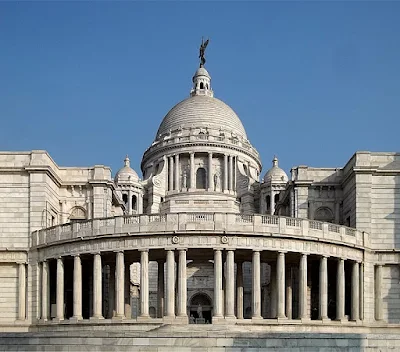Historical Background
The idea of constructing the
Victoria Memorial Hall was conceived in 1901, following the death of Queen
Victoria, the then Empress of India. Lord Curzon, the Viceroy of India at that
time, proposed the creation of a grand monument to honor the Queen's memory.
The foundation stone was laid in 1906, and the memorial was officially opened
to the public in 1921.
The construction of the Victoria
Memorial was funded through voluntary contributions from Indian princely states
and British officials, showcasing the collaborative effort to create a monument
of such scale and grandeur. Sir William Emerson, President of the British
Institute of Architects, was commissioned to design the structure. His design
elegantly fused the classical architecture of the Renaissance with Mughal
elements, creating a unique and captivating monument.
Architectural Splendor
The Victoria Memorial Hall is an
architectural masterpiece that combines elements of the British and Mughal
styles. Made from white Makrana marble, the memorial's design is reminiscent of
the Taj Mahal, symbolizing eternal beauty and grace.
Exterior Design
The exterior of the Victoria
Memorial is adorned with a large central dome surrounded by four smaller domes,
echoing the classical style. Atop the central dome is a 16-foot-high bronze
statue of Victory, holding a bugle in her hand. This statue rotates with the
wind, adding a dynamic element to the otherwise static structure.
The building is surrounded by
expansive gardens designed by Lord Redesdale and Sir David Prain, covering an
area of 64 acres. The lush greenery, interspersed with water bodies and
pathways, provides a serene and picturesque setting, enhancing the memorial's
grandeur.
Interior Design
The interior of the Victoria
Memorial is equally impressive, featuring high ceilings, ornate corridors, and
grand staircases. The central hall, known as the Royal Gallery, houses a series
of oil paintings depicting significant events in Queen Victoria's life,
including her coronation, marriage, and key moments from the British Empire's
history in India.
Museum and Collections
The Victoria Memorial Hall
functions as a museum that preserves and showcases an extensive collection of
artifacts, paintings, sculptures, and manuscripts from the British period in
India. The museum's collection is divided into various galleries, each offering
a glimpse into the rich history and cultural heritage of the era.
The Royal Gallery
The Royal Gallery is the
centerpiece of the museum, featuring oil paintings by renowned artists such as
Winterhalter, Tissot, and Zoffany. These paintings depict various scenes from
Queen Victoria's life and the British Empire's significant events, offering
visitors a visual journey through history.
The Portrait Gallery
The Portrait Gallery houses an
impressive collection of portraits of British royals, viceroys, and other
prominent figures from the colonial period. This gallery provides a fascinating
insight into the personalities who shaped the history of India during British
rule.
The Arms and Armour Gallery
This gallery showcases an array
of weapons and armor used during the British period, including swords, rifles,
and cannons. The collection highlights the technological advancements and
military prowess of the time.
The Calcutta Gallery
The Calcutta Gallery offers a
detailed account of the history and evolution of Kolkata, from its humble
beginnings as a trading post to its development into a bustling metropolis and
the capital of British India. The gallery features maps, photographs, and
artifacts that illustrate the city's transformation over the centuries.
Cultural and Educational Role
Beyond its historical
significance, the Victoria Memorial Hall serves as a cultural and educational
hub. The museum regularly hosts exhibitions, lectures, and cultural events that
promote awareness and appreciation of India's rich history and heritage. These
events attract scholars, historians, and tourists from around the world,
fostering a deeper understanding of the cultural exchanges between India and
Britain.
Gardens and Grounds
The gardens surrounding the
Victoria Memorial Hall are a crucial part of its charm. Designed in the classical
style, they feature wide lawns, formal flower beds, and carefully curated tree
plantations. The gardens are a popular spot for locals and tourists alike,
offering a peaceful retreat from the city's hustle and bustle. The pathways,
dotted with statues and fountains, provide scenic walks and opportunities for
reflection.
Conclusion
The Victoria Memorial Hall stands
as a timeless tribute to the British era in India, embodying the architectural
splendor and historical significance of that period. It is not just a monument
but a repository of art, culture, and history that continues to educate and
inspire generations. As a symbol of Kolkata's rich heritage, the Victoria
Memorial remains an enduring icon, celebrating the city's past while looking
forward to its future. Whether you are a history enthusiast, an art lover, or a
casual visitor, the Victoria Memorial Hall offers a profound and enriching
experience, making it a must-visit destination in India.



.jpg)


.jpg)



.jpg)
.jpg)

.jpg)
.jpg)

.jpg)







.jpg)
.jpg)


Post a Comment